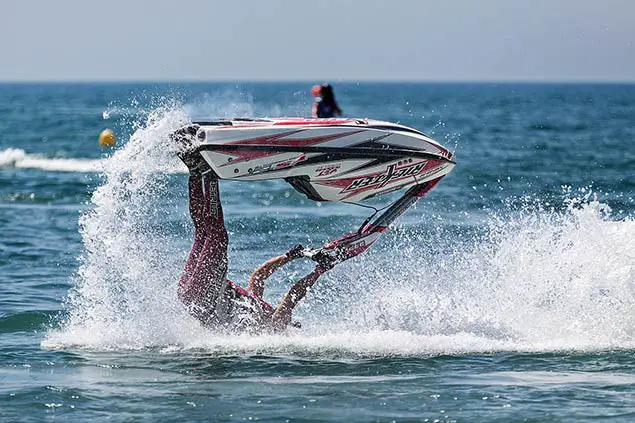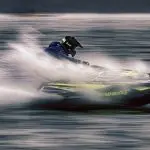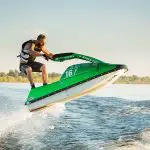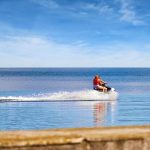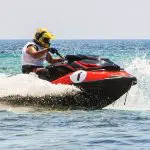Once upon a time, there was the Jet Ski.
And for a good long time, there was nothing else. Kawasaki’s original stand-up JS400 and its successors had the market and the water all to itself for over a decade.
A far different pursuit than riding a modern personal watercraft runabout, riding a jet ski was a highly athletic endeavor that required skill, balance, and dedication – it was a lot like riding a motocross bike, but without the sizeable advantage of having two large gyroscopes in the form of wheels to help keep on upright.
Learning to ride a stand-up ski meant drinking a lot of lake water. Very few riders ever just jumped on board and took off. Most initially floundered, fell, and fell again often.
But once you learned how to weight the hull properly for both straight-line stability and for cornering and how to use the throttle to keep yourself upright and underway, it was tremendously rewarding.
It also provided some of us with an initial skill-set that we still draw on occasionally even riding today’s modern and ridiculously stable personal watercraft.
Contents
In the Beginning
Kawasaki introduced the world’s first stand-up ski in 1972. In various incarnations, it remained the world’s only personal watercraft for almost 15 years.
Originally powered by a 400cc two-stroke twin, the Jet Ski would grow to 440cc in 1977, then to 550cc in 1982. Then, in 1987, one year after the introduction of Kawasaki’s first sit-down ski, the 650cc X2 model, the larger powerplant found itself into an all-new hull for the stand-up market with the JS650.
Horsepower of the first JS400 was a modest number, just 25. The first 550 produced just 41 ponies, with output later being bumped to 47. With the 650 Kawi reached 55 horses.
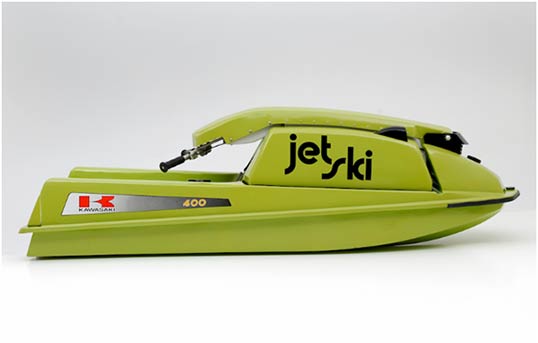
In 1992 Kawasaki reacted to the usurper Yamaha SuperJet, which had debuted in 1990, by once again upping the ante with the 750cc SXI model producing 63 horsepower. The SXI not only had the bigger motor, but was the first stand-up to be equipped with a dual carburetor with the 1995 model year, yielding 75 hp.
The final major revision for Kawasaki came in 2003 in a boat-billed as the SX-R 800, which had an actual displacement of 781cc and produced 80 ponies The SX-R featured a fiberglass reinforced plastic bottom hull and top deck.
Kawi’s 37-year run of producing stand-up skis seemingly came to an end in 2011, as increasingly stringent EPA restrictions caused the manufacturer to finally nail the coffin shut on its two-stroke watercraft.
Yamaha Jumps In
Yamaha entered the stand-up personal watercraft market in 1990 with its first SuperJet.
The initial incarnation of the SuperJet came with a 650cc two-stroke twin engine with a single carburetor, developing 50 horsepower. A 51cc bump in displacement would bump power output up 10 ponies, and the addition of a dual-carb setup would later result in another additional 10 horsepower for 73 total.
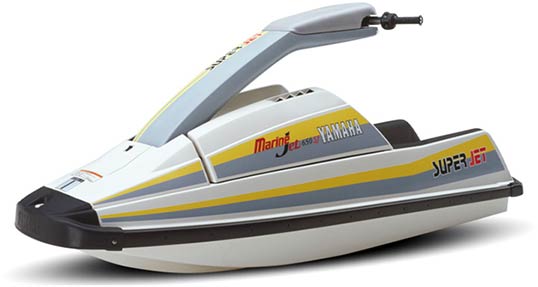
Along with three different engine configurations, Yamaha also changed up the hull just slightly on three different occasions. The original hull, oft referred to as a blunt nose for its squared off front-end design, was a bit easier to get to grips with than the Kawasaki models.
Where the Kawasaki JS550 and JS650, both of which retained loyalists, were razor-sharp handlers that were quite difficult for neophytes to learn to stay on top of, the SuperJet by comparison was somewhat more stable and inviting for newcomers.
When Yamaha pumped in more ponies in 1995 with the 700cc motor, the original hull was retained. The following year, in 1996, Yamaha left the bottom deck unchanged but restyled the top hull into the more aesthetically pleasing “round nose” design in the same model year that dual Mikuni carburetors were added. This second-generation stand-up remained unchanged other than graphics and paint for the next 11 years.
From 2008 through 2020, even as sales continued to dwindle, Yamaha nonetheless served its loyal stand-up enthusiasts with the first true redesign of the bottom deck. Side sponsons were added to the slightly narrowed rear of the hull, and deeper strakes provided better tracking through corners.
This, the final Yamaha two-stroke stand-up, also featured slight changes in the placement of the intake grate, pump, and ride plate for improved performance. The 73 horsepower dual-carb 701 motor soldiered on.
Although Yamaha never abandoned the stand-up market, growingly stringent emissions standards made it difficult to buy a SuperJet in its later years. California’s environmental concerns in particular forced the manufacturer to begin selling the boat for competition use only, and even requiring a racing license for a consumer in order to purchase. Although many dealers overlooked this requirement, SuperJets became very difficult, impossible in some cases, to register for use on public waters.
Clearly, it was time for a change.
The Modern Age
Kawasaki, which had stopped building the SX-R800 in 2011, introduced the world’s first four-stroke powered stand-up in 2016 with the SX-R1500 after a five-year absence from the market.
It took a few years for Yamaha to follow suit, but the all-new four-stroke SuperJet with the company’s 1049cc three-cylinder four-stroke TR-1 marine engine would debut in 2020.
The difference between the two competitors is marked, and in a way represents a swapping of personalities from one to the other.
Whereas the SuperJet had been considered the slightly more user-friendly stand-up to pilot, now Kawasaki had become by far the larger boat, some 142 pounds heavier than the Yamaha!
Tables Turned
With 100 horsepower propelling a hull weighing only 375 pounds, the SuperJet retains all the character of previous stand-up skis. The new Yamaha definitely extends the SuperJet’s advantage over Kawasaki’s Jet Ski, remaining a fast yet nimble craft that still appeals to the racing community and freestyle tricksters alike.
It also extends the appeal to the less accomplished stand-up riders with a learning mode that cuts the engine performance by 15 percent allow newbies to come to grips with the skills required.
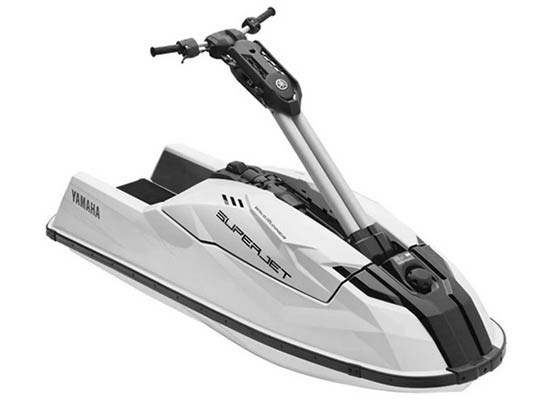
Yamaha hit its mark of keeping the size and weight of its new four-stroke craft as close as possible to its two-stroke predecessor. The new hull is just 7.5 inches longer, 3.2 inches wider, and only 69 pounds heavier than the last two-stroke SuperJet.
The handlepole is now adjustable, offering three resting positions with a length that can be extended or shortened by 50 millimeters. Further, the angle of the steering head nozzle is adjustable from 16 degrees to 19.
While retaining much of the handling characteristics of its predecessors, it’s a bit more stable and easy to ride. The hull’s keel is somewhat flat, and features strakes that grab the water when cornering. It responds best, I think, with the rider’s weight a little further forward than earlier models. Experimenting with handlepole position is the way to achieve optimal results.
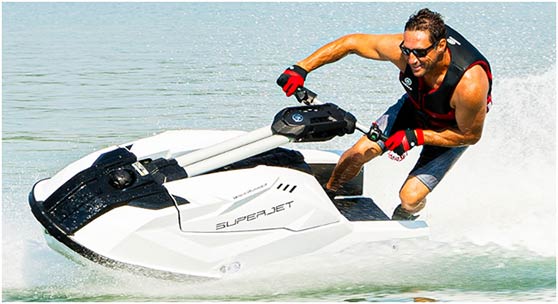
Yamaha’s SuperJet is light, lively, and fun in all the ways stand-ups have always been. It has excellent torque straight off the bottom and accelerates briskly into the mid-50 mph range. I assure you that 50-plus on a stand-up feels much faster than 60-plus on a giant stable runabout.
Speaking of which…
The Behemoth
The Kawasaki, however, is a different deal.
Kawasaki took a different tact with its SX-R 1500, starting with stuffing its 1498cc inline four-cylinder four-stroke motor into a hull that is 14 inches longer and a couple of inches both wider and taller than the final two-stroke SX-R produced.
The result is a package that weighs a whopping 180 pounds more – jumping from 370 to 551!
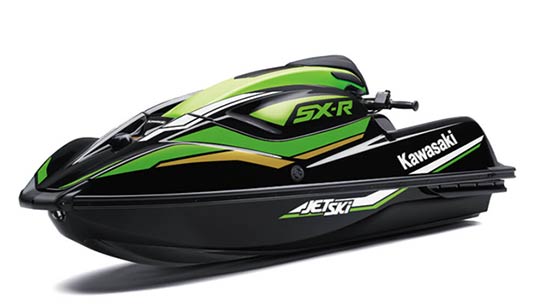
It’s a bit faster on top than Yamaha’s SuperJet, but for me, the stand-up from Kawasaki is kind of the worst of both worlds. It’s as heavy as some small runabouts yet more difficult to ride of course, and even though being difficult to ride is kind of the point, it’s lost a lot of what makes a stand-up ski feel fun to me.
It’s probably the most stable stand-up ever offered, I will say, making it relatively user-friendly for newcomers. I’m just not so sure that mixes all that well with also being the fastest stand-up ever produced.
For the more experienced rider, the SX-R has maybe a bit less punch than the Yamaha at first but it will accelerate smooth and strong right up to 60 mph. It’s also actually a good bit of fun on a buoy course as its length and weight keep it well planted in corners at speed.
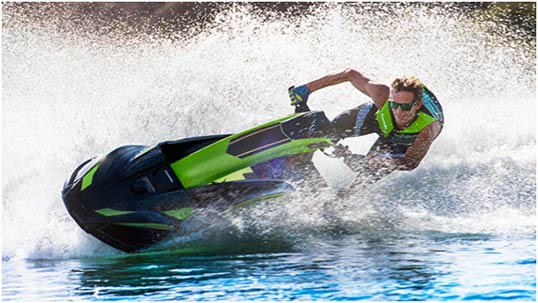
Yet, it unfortunately retains that “planted in the water” feel when jumping waves or doing spins. It’s fast and handles well. It’s just not at all light and lively.
10 Tips To Get Started
Stand-up skis once sold in vast numbers, but now represent only a sliver of new registrations.
For all my reservations about the Kawasaki, I certainly applaud both Kawi and Yamaha for continuing to serve the small but hardcore cadre of riders that still want to ride stand-ups.
If you think you might possibly be one of those riders, but just haven’t tried it yet, here’s the advice I’d give on getting started.
1. Start slow, obviously, and less obvious, don’t stand up yet. Tool around for a bit on your knees. This keeps your center of gravity lower, and will allow you to get some feel for how a stand-up handles, turns, and is always willing to turn right over!
2. When you do attempt to stand up, position your feet diagonally from one another – front foot in the top corner of the footwell, rear foot in the opposite bottom corner. Some riders find it more comfortable to have their dominant foot forward (your right foot if you are right-handed) while others like myself put our dominant leg to the rear. Neither is right or wrong, it’s all in what seems most comfortable.
3. Likewise, approaches vary when turning. I’m from the school that switches back and forth so that I’m always leaning chest first into the corner. In other words, if I’m turning left my right foot is forward, and vice versa. Others – and they’re not wrong – prefer to take advantage of the lower center of gravity that comes from hanging their posterior to the inside of the corner by turning with their back to the turn. Some find shuffling back and forth is too difficult, and simply always maintain the same foot position irrespective of which direction they intend to go.
4. When it comes to turning, you’ll want to start with very gentle lean angles and wide sweeping corners. The key is to get the hang of smoothly feeding in the power with your throttle hand to both to maintain and build momentum. And yes, you’re going to fall over at first.
5. When beginners first try to ride a stand-up ski, one of two opposite mistakes is inevitable. As is moving on to the next! It’s all about accelerating enough to maintain any given lean angle. So, if you go too slow for an initiated turn, your jet ski will lose momentum and inertia is going to take you into the drink. Conversely, neophytes and those who have only ridden runabouts sometimes underestimate the responsiveness of a stand-up ski and crash instead by having the machine shoot out from underneath them. So if you go too slow, you’ll fall. If you go too fast, you’ll crash. Both will inevitably happen. Moving on.
6. As you become more comfortable with lower speed turning, naturally the pace will get faster. Weighting the ski properly involves a lot of trial and error, and even more practice. But one key is to bend at the knees and keep your body weight as low as you can manage while working through the apex of the corner.
7. Keep your elbows bent, and up. Think about the proper form for doing push-ups. You don’t tuck your elbows down and to your sides, right? It’s the same for proper form on a stand-up. Keeping your elbows bent helps pull your body weight forward, and you’ll experience less fatigue in your arms.
8. Experiment with your feet positioning and how you are weighting the hull by simply trying different things while repeating the same maneuver. Do a sweeping turn to the left, for instance, with your left foot forward. Then do the same turn with your right at the point. Learn to ride with the boat, and not against it. Start trying to become comfortable with moving around in the tray while you ride.
9. I almost started with this, but decided to pair it up with the second bit of advice about how to actually get going at all. You won’t be able to balance on a stand-up that isn’t moving. You’ll have to get going to get on. This is most easily accomplished from a shallow water start, with one knee in the tray and one foot on the ground. You’ll gently give it the gas to get moving, just quickly enough to be able to move your other knee up. Then, at a slightly higher rate of speed to maintain balance, you should be able to stand up. The reason I didn’t start with that is that, is because if you’re practicing your turns as noted above you’ll also obviously need to learn to mount up after falling into deeper water where you can’t put a foot down. I used to use the technique of simply pushing the rear of the hull deep enough in the water to get my knees in the tray, while pulling back on the handlebar with my throttle hand. Then accelerating. It’s a bit tricky. Now my knees are pretty hammered from years of this kind of shenanigans, I’ve resorted to another time-honored tactic. I just lay behind the ski, get on the gas – don’t get too crazy, it’s not that comfortable dragging along in the jet wash! – and as soon as I’ve got just a bit of speed going, I’m able to pull myself up into a standing position.
10. Both finally and first and foremost, be patient with your efforts and yourself. Virtually no one steps on a stand-up ski for the first time and reveals themselves as a natural. I’ve seen some truly gifted athletes from somewhat similar pursuits – motorcrossers, wakeboarders, waterskiers – really struggle at first. It’s okay. Everybody does.
Riding a stand-up ski isn’t for everyone, and it certainly isn’t easy. It is, however, one of the most rewarding things to master you’ll ever learn. I’d encourage you to give it a try.
